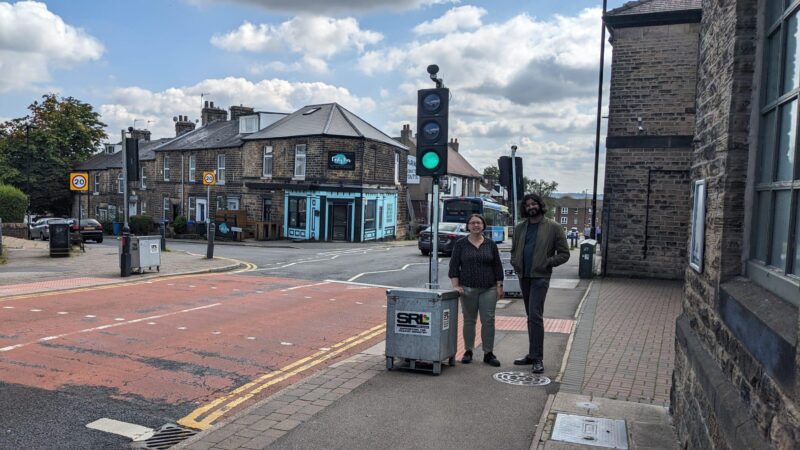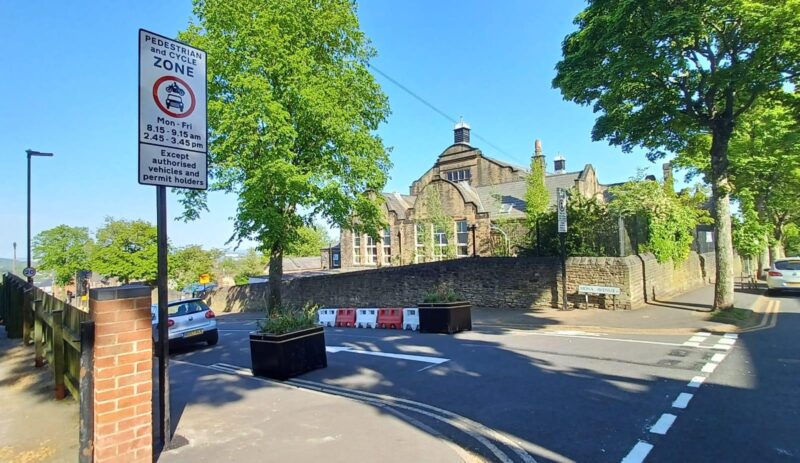September 2023
As the experimental ‘Active Neighbourhood’ scheme in Crookes nears the end of its trial phase, we would like to update on the next steps, and the recommendations that we will be making to those taking the final decisions on each of the trial measures.
On 20th September, the Council’s cross-party Transport, Regeneration and Climate policy committee will decide which trial measures will be retained, modified, or removed permanently. Every measure included in the scheme – whether kept in place for the duration of the trial or not – will be decided upon individually.
As Labour Councillors representing Crookes, we have made recommendations to the committee which we have based on our experience of the trial and the feedback we have received from residents, businesses, and community organisations.
We argued from the start of the trial period for greater public involvement and opportunities for discussion; to support this we organised three ‘Q&A’ sessions where people were able to interact with Transport Planning Officers and Councillors.

Some parts of the scheme we felt would benefit from in-trial enhancements:
- To ease congestion and safe access issues on School Road, we brought in extensive double yellow lines
- We added a No Entry to Mona Road to enable safer travel for schoolchildren from Westways
Some measures have proved unviable for one reason or another; we have advocated for these to be removed from the trial.
We all want to live on streets that are safe for pedestrians, drivers, and cyclists. We want streets where children are safe to play and that are not busy cut-throughs. This is why we have supported the ambitions of the Active Neighbourhood trial and is the framing through which we have approached each measure. The trial was set up to try out ideas for how to make streets more liveable. We believe this is the test each measure should be compared against.
Throughout the project we have been mindful of a wide range of views and experiences that people have told us about and fed into the consultation. Ideally, we would have liked to see more comprehensive data informing the scheme’s design, including greater public involvement and co-production, in addition to a greater range of available measures to encourage and enable active forms of travel. The nature of recent governments’ approaches to funding active travel and public transport initiatives—competitive funding pots pitting us against other local authorities, millions slashed from national budgets, and the managed decline of our public transport network—has meant, unfortunately, that the way local authorities are able to deliver projects such as this one is restricted in scope.
Having experienced, alongside many people in the Crookes area, the frustrations caused by short-sighted government policy, we wish to be clear that we believe any future schemes to enable active travel and reduce car dependency must start from a thorough understanding of the challenges people face in attempting to change their travel habits, and more consideration of creating an alternative. This is why we welcome Sheffield Labour’s proposals to expand our tram network, bring buses under public control, ensure easier and safer transport for all, and involve the public at the heart of any plans.

Crookes ‘Active Neighbourhood’ trial scheme:
Labour Councillors’ recommendations
MEASURES TO RETAIN
Light-controlled Pedestrian Crossings
- Crookes (top of School Road)
- Crookesmoor Road (bottom of Conduit Road)
Modal filters:
- Leamington Street / Townend Street
- Newent Lane
‘School Street’:
- Closure of Mona Avenue to motor vehicles at school drop-off and pick-up times
- No Entry to Mona Road south of Springvale Road
Double Yellow Lines: where these have been implemented as safety enhancements increasing visibility at junctions throughout the scheme area
MODIFICATIONS
Requesting a new pedestrian crossing be implemented on Crookes between Dominos and Hallam Veterinary Centre, to facilitate safe crossing and prioritise pedestrians.
MEASURES TO REMOVE
Modal filters:
- Pickmere Road / Sackville Road
Our thoughts on the measures
We believe that the light-controlled pedestrian crossings have been an overwhelming success, have made navigating Crookes’ main stretch much easier, and helped to better facilitate crossings on the main road. The original Active Travel Neighbourhood designs proposed a third new crossing, on Crookes between the Domino’s and Hallam Veterinary Centre. We have formally requested the Council investigate implementing this crossing to build on the strengths of the scheme and facilitate safe pedestrian access.
We believe that the modal filters at the junction of Leamington Street, Townend Street and Hands Road, and similarly Newent Lane, have achieved their ambition of reducing traffic and creating a safer, quieter environment for all. We look forward to seeing designs drawn up—in conjunction with the local community—for making these measures permanent. We have requested the Council to consider ways in which a Newent Lane that is permanently opened to pedestrians and cyclist traffic can be made greener and more vibrant. We would also like to see some new planting built into the permanent measures that will replace the Leamington Street filter.
We believe that the ‘school street’ on Mona Avenue has created a safer environment for parents and guardians to collect children from Westways. We note there have been issues with abuse of the measure—which the no entry to Mona Road was introduced to redress—and that there have been issues with volunteers to support the maintenance of the school street. We would repeat the call of Westways and the Council for any volunteers who would be happy to facilitate the school street during term-time.
From the beginning of the trial, we believed the lack of consideration of on double parking on School Road was a clear omission in the scheme’s design. We pushed for double yellow lines to be added to the length of the road and are pleased that the presence of the trial made it easier to get approval for the addition of these double yellow lines. We hope their addition will end the possibility of fire engines or other emergency vehicles getting stuck on School Road due to double-parked cars and consider the addition of these DYLs a success of the scheme. We note there are concerns about motorists using the absence of double-parked cars as an excuse to speed up the road and are therefore will be deploying the LAC’s Vehicle Activated Sign to monitor speeds on this road.
Following close consultation with residents and businesses, as well as St Vincent’s Church on Pickmere Road, we have suggested that the modal filter at the junction of Pickmere Road/Sackville Road be removed. Testimony from residents as well as data gathered by Transport Officers suggests that this measure has had a minimal impact on an already quiet residential road, but a significant impact on churchgoers at St Vincent’s, including to funeral processions.
We note that the ward is due to host some cycle hangars to ease issues of households not having space for cycle storage. We look forward to monitoring their usage once they are installed.
Where planters are to be removed, we have asked the Council to consider offering these for community use and exploring whether Westways or other local schools might be interested in using them for community-planting.
Looking forwards
We believe there are clear lessons to be learnt for the Council when considering future schemes. Right from the beginning we heard serious concerns from residents and businesses. As we have said previously, people who liked the changes as well as people who did not, told us that the initial public engagement and design process should have been much better. Through our Local Area Committee, we organised public consultation events to bring community voice back to the heart of these plans and ensure concerns could be heard and addressed. But the lack of public consultation meant that the schemes were on the backfoot from the start. Any future Active Neighbourhoods must be co-designed by the communities that live in the schemes and who will see the potential benefits.
We also have grave concerns about this Conservative Government’s haphazard approach to active travel and public transportation. In March 2023, the Government cut £200m from England’s active travel budget. The Prime Minister, Rishi Sunak, later ordered a review of low-traffic neighbourhood schemes. Due to the long-term impact of austerity and the halving of local government funding, active travel has in recent years been funded through Government-initiated projects, often announced at short notice and with little strategic direction. Likewise, this Government has overseen a managed decline of our bus services. South Yorkshire’s Mayor Oliver Coppard recently reported that, despite promising “London-style bus services” in every region, the Government gave our region no funding in its latest bus funding schemes. The result of such cuts is South Yorkshire losing 40% of its bus network since the Tories came to power.
We cannot ignore the national context and the impact it has on such schemes. It is difficult, if not impossible, to plan for modal shift without a viable public transport network. As local councillors we will do what we can to advocate for the infrastructure we need—including advocating for a radical expansion of the tram, to bring the buses into public control and ultimately ownership—but local government cannot do this alone. We need a Government that is a willing partner in this fight, has ambitions for our communities, and will ensure the powers and funding necessary to deliver healthy communities and a liveable planet. We therefore welcome the large parts of this scheme that have been a success, but lament the opportunities missed from the lack of ambition from national partners.

